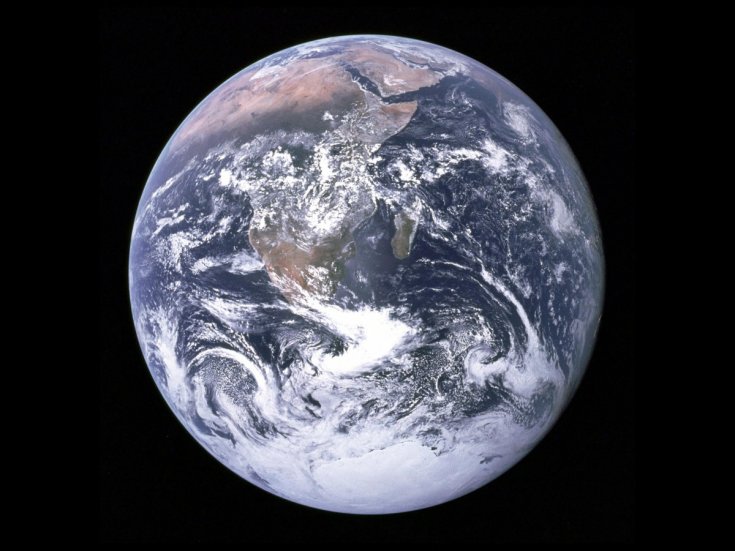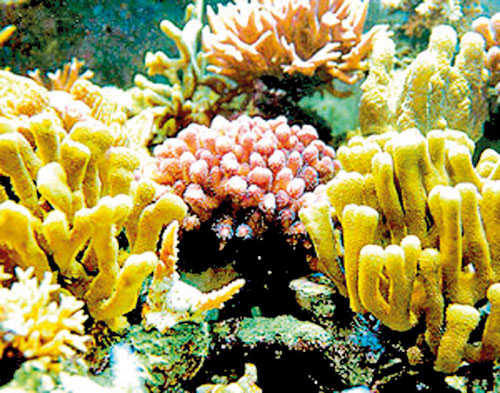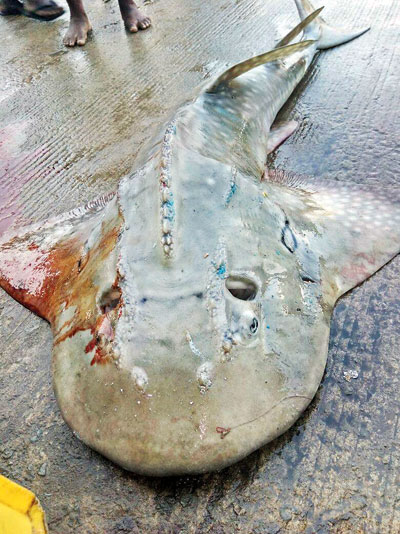
Earth Day is celebrated on 22 April 2017 in the hope of boosting climate literacy.
Earth Day is celebrated every year on 22 April, to honour our planet and shed a light on environmental issues that matter. It promotes an ideal of peace and sustainability for all.
This year’s campaign is dedicated to an ambitious goal – to achieve global climate and environmental literacy in the space of three years, by Earth Day 2020.
Source – 21/04/2017,International Business Times, see more at – http://www.ibtimes.co.uk/earth-day-2017-theme-events-all-you-need-know-about-global-campaign-1617809

Marine pollution around Sri Lanka and the inevitable environmental disaster
By Carmel Corea
The National Geographic Magazine April 2017 issue carries a satellite image showing the polluted waters around Sri Lanka. This irrefutable evidence indicates a possible environmental disaster for Sri Lanka’s coral reefs.
Coral reefs protect Sri Lanka from natural disasters and are essential for sustaining this country’s fishing industry. The tourism industry boldly advertises Sri Lanka’s pristine beaches and states, “Investors favour coastal belt tourism development’.
In view of recent research, environmentalists warn that unless urgent measures are taken to control marine pollution, the financial loss and income downturn to the country will be inevitable.
What is marine pollution?
Marine pollution occurs when harmful or potentially harmful chemicals, materials, pathogens or disruptive activities invade the oceans. Eighty percent of marine pollution comes from the land. Air, too, contributes by carrying pesticides, toxic gases, hot air and sound, all proven to be harmful to marine life and habitats.
Greenpeace UK’s senior ocean campaigner Louise Edge says more than 12 million tons of plastic end up in the oceans each year.
Sri Lanka is the world’s fifth worst ocean plastic polluter, with China topping the list. Fisherman say pollution is killing marine life and their livelihood.
The United Nations will hold an Ocean Conference from June 5 to 9 to reverse the decline in the health of oceans for the benefit of the people and the planet.
Global warming stresses the environment
Global warming — due to an increase in greenhouse gases (GHG) such as carbon dioxide produced mainly by anthropogenic (human) activities — is causing climate change.
Records indicate atmospheric carbon levels increased from 280 to 400 parts per million from 1750 to 2015, resulting in atmospheric warming.
Researches state that our oceans absorb about 30 million tons of carbon dioxide every day changing the chemistry of the sea and increasing its acidification.
This reduces sea water’s carrying capacity for calcium carbonate needed by corals and other marine organisms to build their exoskeletons. Hence coral reefs are under survival threat and need careful management.
Sri Lanka formally ratified the Paris Agreement to limit GHG emissions on April 22 last year.
The importance of coral reefs to Sri Lanka
Coral reefs are vital for Sri Lanka’s economy. They are the ‘rain forest of the sea’ — the most bio-diverse and productive ecosystem on earth, occupying only 0.2% of the ocean, yet home to a quarter of all marine species. More than 4000 species of fish make coral reefs their home. Corals can only exist within a narrow band of environmental conditions found in tropical and subtropical waters. The water temperature must remain ideally between 23C and 29C (or 77F and 84F).
The conditions needed for coral survival are found in the seas surrounding Sri Lanka. This makes Sri Lanka a unique island, with potential for developing into a high foreign income generating eco-tourist resort.
Coral reef destruction and sewage pollution
Dr. Stephanie Wear, the Nature Conservancy (USA) lead scientist for coral conservation, has carried out extensive research on marine pollution. She says, “When you think of the top threats to coral reefs sewage isn’t usually at the top of the list. Climate change and over fishing are the more familiar hazards, but pollution from untreated sewage is a serious threat to reefs and the services they provide for marine life and people.”
Dr.Wear elaborates that some of the greatest sewage pollution in the world occurs in developing countries, where most coral reefs exist. It appears that the infrastructure in sewage waste management in these countries may be old, and poorly maintained – and that causes untreated sewage to be pumped into the sea.
A similar situation exists in Sri Lanka. Nihal Fernando, Project Director (Colombo Port City) and Urban Development Authority Director, in an article published in this newspaper on June 19 last year states, “… thousands of metric tonnes of raw sewage are annually discharged to sea.”
Source – 09/04/2017, The suinday Times , See more at – http://www.sundaytimes.lk/170409/sunday-times-2/marine-pollution-around-sri-lanka-and-the-inevitable-environmental-disaster-236258.html

Rare bottom-dweller is a vulnerable fish
The Shark Ray or Guitar fish with fins similar to that of sharks and upper body similar to a ray
In the animal kingdom, there are species that look alike, or ‘hybrids’, between two or more creatures. Marine creatures with such features often go unnoticed, but the fish caught in nets off the southern coast puzzled many as it appeared like a shark and a ray (‘mora’ and ‘maduwa’ in Sinhala, respectively).
This strange fish had ‘shark like’ fins and tail. However, its head looks like a ray and had ray-like ‘wings’. The fish photographed by Devsiri Peiris last month is said to have been caught accidentally in a fishing net. It is about five feet long and a male.
“It is a fish we call ‘shark ray’, known by fishermen as ‘thith mora’’’, says Rex I. De Silva – an expert on sharks. “Despite its Sinhala name, it is not a shark but a ray,’’ he says.
The shark ray is scientifically named as Rhina ancylostoma also called mud skate as it is found in sandy bottoms doing bottom feeding. Due to the shape of its head the fish in this group is also known as ‘guitarfish’. The one caught is a Bowmouth Guitarfish. According to literature, this large species can reach a length of 2.7 m (8.9 ft) and weight of 135 kg (298 lb). They are found in depths of up to 90 m (300 ft).
Shark expert, Mr de Silva says the species is rare. “Nevertheless the species appears in very small numbers from time-to-time in fish markets. I have seen them at Negombo, Kalmunai and Kirinda markets,” Mr De Silva says.
The Red List of Threatened Fauna by IUCN categorises the shark ray as ‘Vulnerable’ to extinction. Other than getting caught in fishing nets, dynamite fishing, bottom trawling pose a threat to shark rays. Habitat degradation and destruction too threaten this rare fish.
Source – 09/04/2017/ The Sunday Time, See more at – http://www.sundaytimes.lk/170409/news/rare-bottom-dweller-is-a-vulnerable-fish-236477.html

Body of Dolphin found with rear fins cut off
Wildlife officers have discovered the body of a Dolphin floating inside the Hambantota Fisheries Harbor. Officers said the dolphin’s rear fins had been severed.
It is suspected that the dolphin had got caught in a fishin net but had been brought ashore by the fishermen rather than being released back into the sea. Wildlife officers said they had previously discovered dead sear turtles who had also gotten caught in the nets of fishermen.
They warn that despite a ban on the killing of dolphins, there was still an underground trade in the sale of dolphin meat.
While no comprehensive survey has been carried out regarding dolphin populations off the island’s shores, the Marine Environment Protection Authority estimates there are some 10,000 dolphins around the regions of Trincomalee, Kalpitiya and Mirissa.
source – 20/04/2017, Times Online, See more at – http://www.sundaytimes.lk/article/1020312/body-of-dolphin-found-with-rear-fins-cut-off







